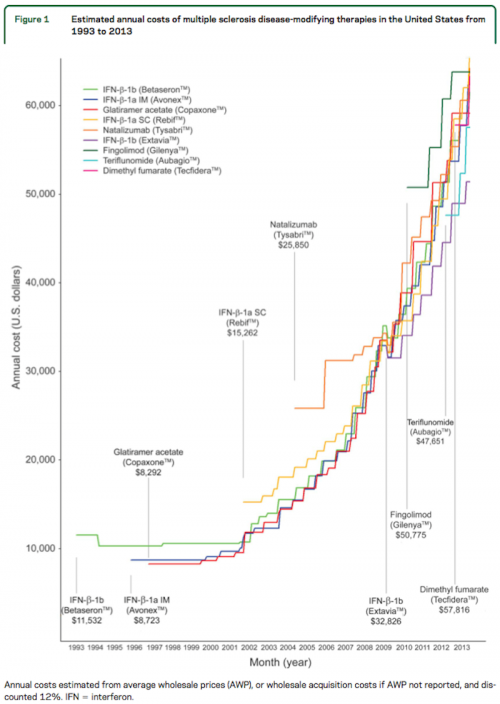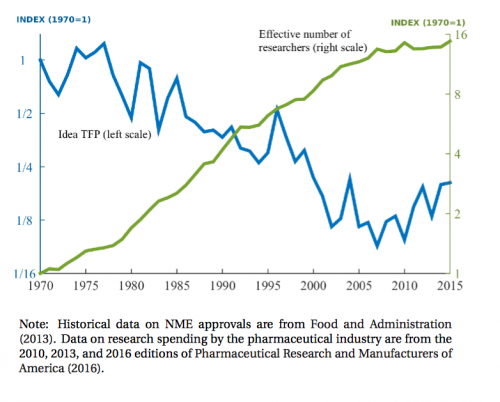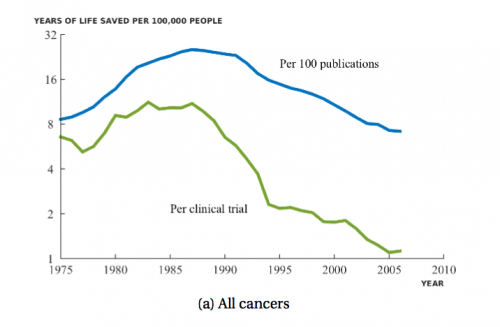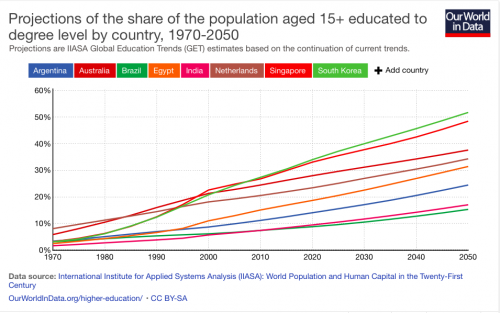Nicholas Bloom, Charles Jones, John Van Reenen, and Michael Webb have a draft article asking a fundamental question: Is it getting harder to generate a new scientific finding?
If it is getting harder, that’s bad news for medicine. Austin had a post a few months ago about increasing drug prices (see also the Figure below, from Elie Kincaid):
The rate of increase in drug prices has outpaced that of overall medical care every year since 2008. A recent survey found that retail prices of selected brand-name dermatological medications increased an average of 401% between 2009 and 2015 (363% in real terms, accounting for inflation), while prices of the generic medications increased an average of 279% between 2011 and 2014 (265% in real terms).

Why are prices rising? In part, it’s predatory behaviour by pharmaceutical companies. But it is also possible that drug price increases occur in part because it’s getting more difficult to develop new pharmaceuticals.
Bloom et al. ask us to consider phenomena like
…Moore’s Law, one of the key drivers of economic growth in recent decades. This “law” refers to the empirical regularity that the number of transistors packed onto a computer chip doubles approximately every two years. Such doubling corresponds to a constant exponential growth rate of around 35% per year, a rate that has been remarkably steady for nearly half a century.
Moore’s law has been presented as if the technology industry had a cornucopia. A constant stream of scientific and engineering innovations generates exponential growth, year after year. But that story ignores the increasing costs of achieving these innovations.
[constant] growth [in chip density] has been achieved by putting an ever-growing number of researchers to work on pushing Moore’s Law forward. In particular, the number of researchers required to achieve the doubling of chip density today is more than 25 times larger than the number required in the early 1970s. At least as far as semiconductors are concerned, ideas are getting harder and harder to find.
This 25-fold increase in the workforce implies that the productivity of researchers — their ability to generate the ideas that sustain growth — must be declining over time.
The basic insight of this paper can be explained with a simple equation, highlighting a stylized view of economic growth that emerges from idea-based growth models:
Economic Growth Rate = Idea TFP × Number of researchers.
“Idea TFP” (Total Factor Productivity) is thought to be the rate at which a researcher can generate new ideas. It reflects both the skills and effort of the researcher and the difficulty of the problems that she is trying to solve. Bloom et al. argue that
a wide range of empirical evidence [shows] that in many different contexts…, research effort is rising substantially [over time], while research productivity is declining sharply. Steady [economic] growth, when it occurs, results from the offsetting of these two trends. [emphasis added]
The authors look specifically at the productivity of medical research. Again, even though the numbers of medical researchers are increasing, progress in human well being is, in their view, at best constant. For example, the number of new molecular entities (NMEs) approved by the FDA is roughly constant. Given that it’s constant, the idea TFP for NMEs must be declining.

It gets worse. Bloom et al. produce data indicating that the number of lives saved per cancer research publication or per clinical trial is declining, a nearly 8-fold decline over 30 years in the lives saved / 100,000 population per cancer clinical trial.

A decline in medical idea TFP is particularly scary in light of the declining effectiveness of antibiotics. We need to be constantly replacing these drugs and it’s not helping if good new antibiotics are getting harder to find.
Why would idea TFP decline? I don’t believe that the skills, efforts, or tools of individual researchers are deteriorating; if anything they’re improving. It’s much more plausible that we are in a regime of steeply diminishing returns to investment in research. The low hanging fruit has been picked and frontier problems in science and engineering are deeper and harder. This problem won’t go away. The more progress we make, the steeper our learning curve will get.
What can we do? As Alex Tabbarok notes, the Bloom et al. model points at two solutions. We can either increase the idea TFP of an individual researcher or we can increase the number of researchers.
We can certainly increase the number of researchers. Global inequality of economic development means that many millions of children across the world never get an opportunity to become researchers. Reductions in global poverty mean that millions more children will receive secondary and tertiary educations in the next forty years.

Within developed countries, social and economic barriers limit educational and professional opportunities for many students, particularly women and minorities.
I want to highlight the connection between inequality and scientific progress. Modern progress in human well-being depends in large part on science. Scientific productivity is challenged by its own success: progress gets more difficult as we solve the accessible problems. However, science is a collective enterprise. The larger the community devoted to science, the more problems we will solve. We can grow that community by raising human capabilities within developed societies and across the globe.
This connection gives us a new motivation for concern about human inequality. Egalitarianism is sometimes viewed as a preference or, in Jon Haidt’s view, a kind of taste for fairness. We may have such tastes, but that’s not the whole story. Our long term interests as a species are also at stake. Egalitarianism as a commitment to the full development of everyone’s capabilities may be a prerequisite to continued exponential growth in human well-being.
Of course, the human population can’t increase indefinitely. If Bloom et al. are right, as diminishing returns to research get more severe, then progress will slow for a fixed population unless we get smarter. Perhaps humans can be made dramatically more intelligent by hacking our genomes, or direct neural connections between brains and artificially intelligent machines, or by some other variant of transhumanism. Currently no one has any idea how to do such things.

